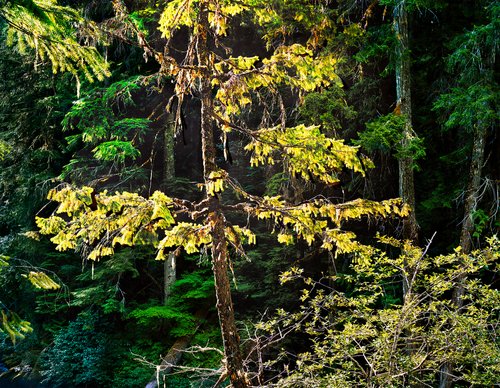Nature is a wealth of inspiration. It offers a vast array of colors and textures that evoke a mood or feeling along with shapes and lines that twist and tumble, creating unexpected pathways or revealing hidden stories. Light, too, can create a game of hide and seek amongst the flora and fauna, such as the sun streaming through a crooked branch, casting shadows onto a dense forest floor. Nature is also a witness to history—its many layers telling stories of peace, conflict, or more and hinting at our collective future.
Seattle-born, Portland-based photographer Sadie Wechsler summons nature in her contribution to the Frye Art Museum’s Boren Banner Series. Wechsler crafts images that are the result of intensive research, often focusing on shifting environments and their histories. Her piece at the Frye, Between the Tideflats and the Lake, is inspired by the ecological history of the Frye's First Hill neighborhood. Rather than a nostalgic or romanticized semblance of the past, Wechsler aims to create an image that urges viewers to consider more deeply the species and terrain that surround them.
Influenced by her billboard-sized photograph, Wechsler and the Frye compiled a list of local Seattle parks where you, too, might find inspiration. We hope it prompts you to explore the flora and fauna of our city, get to know your neighborhood in a new way, and enjoy some fresh air!

Sadie Wechsler. Between the Tideflats and the Lake, 2021. Digital photograph on vinyl. 16 x 20 ft. Courtesy of the artist.
3801 Discovery Park Blvd., Seattle, WA 98199
Discovery Park is the largest city park in Seattle and occupies most of the former Fort Lawton site. Situated on Magnolia Bluff overlooking Puget Sound, Discovery Park offers spectacular views of both the Cascade and the Olympic Mountain ranges. The secluded site includes two miles of protected tidal beaches as well as open meadow lands, dramatic sea cliffs, forest groves, active sand dunes, thickets, and streams. The role of Discovery Park is to provide an open space of quiet and tranquility away from the stress and activity of the city, a sanctuary for wildlife, as well as an outdoor classroom for people to learn about the natural world.
2451 Delmar Dr. E, Seattle, WA 98102
Interlaken Park is a densely wooded area on the north end of Capitol Hill. The paths and trails throughout the park are frequented by bikers, hikers, and joggers.
*Join the Frye and Boren Banner Series artist Sadie Wechsler on Sunday, April 3 for an outdoor tour of this beloved Seattle park! Learn more and register on our website.
4503 Beach Dr. SW, Seattle, WA 98116
Most of the Me-Kwa-Mooks Park stretches up the hillside and extends north and farther south on land that is largely undeveloped. The dense trees provide habitat for many birds, including screech owls. Picnic tables are set up near the park’s entrance. Immediately across the street is a rocky beach that is accessible during low tide and whose tide pools are rich in limpets, lumpsuckers, nudibranches, and sea stars, to name a few.
950 E Roanoke St., Seattle, WA 98102
Roanoke Park is a grassy, pleasant space located on north Capitol Hill. Located in a residential area, it has fruit trees that burst into color in the spring; it's an ideal place to enjoy a picnic while kids frolic in the play area.
5551 SW Admiral Way, Seattle, WA 98116
Schmitz Preserve Park has old growth forest, walking paths, hiking, and nature study. The land was donated between 1908 and 1912 by German immigrants Ferdinand and Emma Schmitz, who saw how rapidly the great forest was disappearing and wanted to preserve part of it in its natural state.
5900 Lake Washington Blvd. S, Seattle, WA 98118
Within the Seattle city limits, Seward Park boasts 300 acres of beautiful forest land, home to eagles' nests, old growth forest, a 2.4 mile bike and walking path, an amphitheater, a native plant garden, an art studio, miles of hiking trails, shoreline, beaches, and more. The park features a number of boat launches, as well.
14445 Juanita Dr NE, Kenmore, WA 98028
Set on the eastern shore of Lake Washington, surrounded by low forest and lawns, Saint Edward's Seminary is not hard to picture as it was in the 1930s, with hundreds of students in residence. These days, Saint Edward State Park bursts with modern life. Kids enjoy unstructured fun on the grass fields and playground equipment, kayakers cruise Lake Washington and hikers and mountain bikers take to the trails.
The Frye Art Museum resides on the traditional territories of the Coast Salish peoples, specifically the Duwamish and Suquamish tribes, who have stewarded the lands and waters of what we now call Seattle since time immemorial. Please join us in extending gratitude to their elders past and present as well as future generations for their stewardship.
Learn more about the Indigenous lands and people in your specific area.